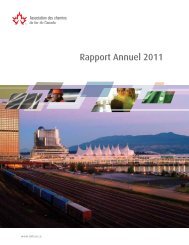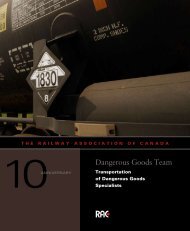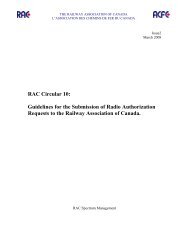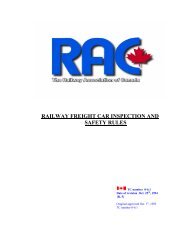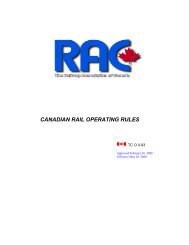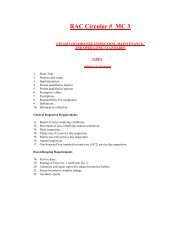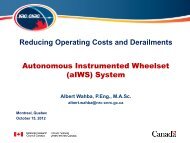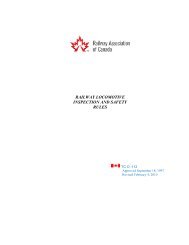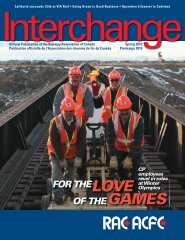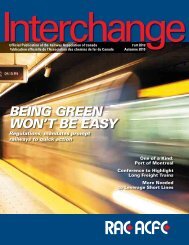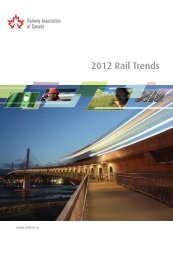Locomotive Emissions Monitoring Program - Railway Association of ...
Locomotive Emissions Monitoring Program - Railway Association of ...
Locomotive Emissions Monitoring Program - Railway Association of ...
Create successful ePaper yourself
Turn your PDF publications into a flip-book with our unique Google optimized e-Paper software.
8 Summary and Conclusions<br />
The economic downturn in 2008 impacted on the Canadian railways’ ability to maintain a steady improvement in<br />
operational efficiency as measured by fuel consumption and to meet the emissions intensity targets <strong>of</strong> the MOU.<br />
At the time that GHG emissions intensity targets in the MOU were negotiated, the assumption was that RTK traffic<br />
would grow by 3.0 per cent during the course <strong>of</strong> the MOU. When freight railways experience growth in traffic and use<br />
scheduled railway operations, they have the ability to run longer and heavier trains, thus improving GHG emissions<br />
intensity levels. However with the downturn in traffic in 2008, the railways scheduled shorter and lighter trains<br />
resulting in higher GHG intensity levels. RTK traffic in 2008 decreased 4.2 per cent from the 2007 level. The downturn<br />
in RKT traffic became particularly acute in the fourth quarter <strong>of</strong> 2008 when the Canadian economy contracted at an<br />
annualized rate <strong>of</strong> 3.7 per cent. The direct negative impact on freight railway traffic was a decline <strong>of</strong> 20 per cent on<br />
a year-over-year basis. Unfortunately the impact on emissions intensity levels <strong>of</strong> the decrease in RTK traffic could<br />
not be <strong>of</strong>fset by the number <strong>of</strong> efficiency improvements being undertaken by the freight railways.<br />
In meeting the objectives <strong>of</strong> the MOU, the particulars experienced by the 54 RAC member railways as <strong>of</strong> end <strong>of</strong><br />
2008 were:<br />
a. Relative to the targets specified in the MOU for 2010, the emissions intensity levels <strong>of</strong> GHG (as CO 2 equivalent ) by<br />
category <strong>of</strong> operation for 2008 compared to previous years were:<br />
<strong>Railway</strong> Operation Units 2006 2007 2008 MOU 2010 target<br />
Class I Freight kg / 1,000 RTK 17.79 17.32 17.61 16.98<br />
Regional and Short Lines kg / 1,000 RTK 15.10 15.21 15.80 15.38<br />
Intercity Passenger kg / passenger-km 0.13 0.13 0.12 0.12<br />
Commuter Rail kg / passenger 1.74 1.71 1.74 1.46<br />
b. GHG emissions from all railway operations in Canada totalled 6564.44 kt, down 2.4 per cent from 6,727.65 kt in<br />
2007 reflecting a reduction in fuel consumption due to a 4.2 per cent drop in freight RTK traffic. For all freight<br />
operations, the GHG emissions intensity (in kg <strong>of</strong> CO 2 equivalent per 1,000 RTK) increased from 17.75 in 2007 to 18.05<br />
in 2008. However, compared to 23.88 in 1990, it is a 24.4 per cent improvement.<br />
c. For Commuter Rail operations, the increase in GHG intensity levels to 1.74 kg per passenger from 1.71 in 2007<br />
can be attributed to the introduction <strong>of</strong> additional scheduling and the operation <strong>of</strong> longer trains in 2008.<br />
Furthermore, new high-horsepower locomotives were employed to move the longer trainsets. In 2008, GO Transit<br />
suspended use <strong>of</strong> the proprietary FTC fuel extender additive pending resolution <strong>of</strong> warranty concerns on its<br />
new locomotives. This combination <strong>of</strong> events negatively impacted the GHG intensity level. Generally, when new<br />
service routes are introduced it takes a period <strong>of</strong> time to increase ridership to fill new capacity.<br />
d. NOx emissions from all rail operations in 2008 totalled 99.68 kt. Compared to 2007, this is a reduction <strong>of</strong> 3.4 per<br />
cent and is 12.2 per cent below the 1995-2005 MOU reference level <strong>of</strong> 115 kt per year. The emissions <strong>of</strong> NOx have<br />
averaged 112.98 kt per year since 1990.<br />
e. In terms <strong>of</strong> emissions intensity, the NOx level in 2008 for freight trains was 0.27 kg per 1,000 RTK, the same value<br />
as 2007. The 37.2 per cent reduction below the 1990 level <strong>of</strong> 0.43 kg stems primarily from the beneficial effect <strong>of</strong><br />
acquiring new locomotives meeting U.S. EPA emissions standards as well as upgrading in-service locomotives to<br />
EPA Tier 0 emissions limits.<br />
f. The in-service diesel-powered Canadian freight and passenger railway locomotive and DMU fleet totalled 2,823<br />
units in 2008. There were 1,110 locomotives compliant with the U.S. EPA emissions limits, which is 46.4 per cent<br />
<strong>of</strong> the line-haul fleet.<br />
g. The number <strong>of</strong> locomotives equipped with Automatic Engine Stop-Start systems to minimize unnecessary idling<br />
totalled 1,104, which is 39.1 per cent <strong>of</strong> the in-service fleet.<br />
35 LEM 2008





